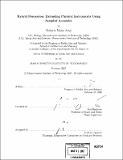Hybrid percussion : extending physical instruments using sampled acoustics
Author(s)
Aimi, Roberto Mario, 1973-
DownloadFull printable version (21.51Mb)
Alternative title
Extending physical instruments using sampled acoustics
Other Contributors
Massachusetts Institute of Technology. Dept. of Architecture. Program In Media Arts and Sciences
Advisor
Tod Machover.
Terms of use
Metadata
Show full item recordAbstract
This thesis presents a system architecture for creating hybrid digital-acoustic percussion instruments by combining extensions of existing signal processing techniques with specially-designed semi-acoustic physical controllers. This work aims to provide greater realism to digital percussion, gaining much of the richness and understandability of acoustic instruments while preserving the flexibility of digital systems. For this thesis, I have collaborated with percussionists to develop a range of instruments, to refine and extend the algorithmic and physical designs, and to determine successful models of interaction. Conventional percussion controllers measure and discretize the intensity of strikes into discrete trigger messages, but they also ignore the timbre of the hits and fail to track more ambiguous input. In this work, the continuous acoustic output of a struck physical object is processed to add the resonance of a sampled instrument. This is achieved by employing existing low-latency convolution algorithms which have been extended to give the player control over features such as damping, spectral flattening, nonlinear effects, and pitch. (cont.) One of the advantages of this approach is that light taps, scrapes, rubs, or stirring with brushes all take on a hybrid timbre of the real and sampled sound that is surprisingly realistic and controllable. Since part of its behavior is inherently acoustic, a player's intuition about interacting with physical objects can be applied to controlling it. The ability to transform the apparent acoustic properties of objects also suggests applications to HCI and product design contexts.
Description
Thesis (Ph. D.)--Massachusetts Institute of Technology, School of Architecture and Planning, Program in Media Arts and Sciences, 2007. Includes bibliographical references (p. 133-138).
Date issued
2007Department
Program in Media Arts and Sciences (Massachusetts Institute of Technology)Publisher
Massachusetts Institute of Technology
Keywords
Architecture. Program In Media Arts and Sciences